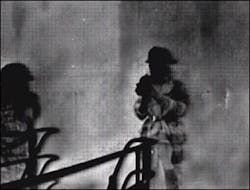Last month’s column was the first in a three-part series that emphasizes key safety issues during thermal imager (TI) use. The ease with which most TIs can be operated today breeds an overconfidence and over-reliance on the tool; both of these can have dangerous consequences if firefighters do not train themselves to resist temptation.
Five Deadly Sins
The first part of this series identified the “Five Deadly Sins†of thermal imaging, which are:
1. Standing and Walking in Unsafe Environments
2. Abandoning Traditional Safe-Search Techniques
3. Advancing at an Inappropriate Speed
4. Misinterpreting Images
5. Misapplying Technology
These “Deadly Sins†apply to a wide variety of situational quirks, activities and misjudgments that can place firefighters in unsafe positions. As with most potential problems, awareness is critical to avoiding the pitfall. Then, practice in safe techniques reinforces proper behavior. This installment focuses on the “Second Deadly Sin:†Abandoning Traditional Safe-Search Techniques.
Abandoning Traditional Safe-Search Techniques
The restricted visibility that firefighters typically experience in structure fires helps deter them from overextending themselves; however, a firefighter with a TI does not have restricted visibility. The ability to “see†can raise his confidence level, often tempting him to engage in higher-risk operations or to ignore danger signs.
Take, for example, a recent training exercise in Illinois. Firefighters practicing with thermal imagers, even after specific instruction on how to proceed through a smoke-filled structure, engaged in unsafe operations. One acting officer walked next to the crawling hose team until they entered the fire room. Another firefighter split off from his company to do a right-hand search while his two partners went left. Yet another followed his company on a left-hand search, then when ordered to search a specific area, he continued by himself on a right-hand search. The ability to “see†brought overconfidence to the teams, and they began ignoring basic safety practices.
Firefighters cannot confuse “visibility†with “safety.†Operations that are conducted with a hoseline or ropeline without a TI must be conducted with a hoseline or ropeline with a TI. Search patterns must still be coordinated and easily reversible. At any point, a TI-equipped team could lose its thermal imager or have the battery fail. The firefighters would then have to continue their operation without the benefit of the TI and, more importantly, navigate their way out of the building without the TI. Firefighters still must keep a mental map of the structure, ensuring that they are aware of their approximate location inside the structure as well as their primary and secondary egress points.
Training for Safety
To address safety considerations in hostile environments, supervisors must ensure that their firefighters properly perform searches with and without a thermal imager. A successful training program will have three primary components. First, training must require firefighters to use a thermal imager while performing normal fireground operations, including advancing hoselines and performing searches. By incorporating the TI with other operations, leaders can emphasize that it is a tool to help with that function, not intended as a standalone operation. This approach also gives members familiarity with using the TI in primary operations.
Second, all training evolutions must be monitored by instructors or supervisors. Ideally, this is done with another TI, so leaders have a means of verifying that safe habits are reinforced. After all, training with faulty methods does not promote firefighter safety. Leaders must see what trainees are doing to ensure that they are performing properly, following both common safety practices as well as department procedures. A wireless transmitter can assist instructors in monitoring training drills.
Third, TI-based training should include random simulations of equipment failure. Instructors can either take the TI (simulating loss) or remove the TI’s battery (simulating failure), then order the firefighters to continue operations or evacuate. By emphasizing both options, firefighters will learn that they can continue their work despite the loss of a TI. By training regularly without thermal imaging as an aid, firefighters will also remain proficient with their standard skills in the event that a TI is not available to them at an incident.
Conclusion
By identifying potential problems in advance, firefighters can train to avoid them. Awareness of the likely pitfalls will also help firefighters retain their basic skills and ensure that they utilize them, even when they are operating with the assistance of a TI. Leaders can develop training programs that teach users how to integrate the TI into standard operations, as well as how to adapt to the unexpected loss of the TI during operations.
For more information on searching safely with a thermal imager, visit the Technology section of Firehouse.com.
Jonathan Bastian is a thermal imaging specialist for Bullard. He is certified as a thermal imaging instructor by the Law Enforcement Thermographers’ Association (LETA). He is also the author of the FD Training Network “FireNotes†book, Thermal Imaging for the Fire Service. Bastian served 12 years on the North Park, IL, Fire Department, including the last three as a captain. He has taught classes on thermal imaging, rapid intervention teams and search and rescue operations. He is currently a public safety official in central Kentucky. If you have questions about thermal imaging, please send them to [email protected].






